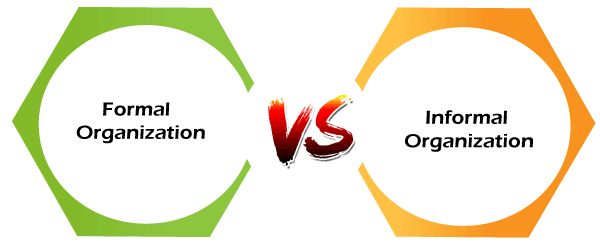Difference between Formal and Informal OrganizationToday more than half of the youth of the country are working. People work in several companies and organizations. Every organization works in a different way. For instance, there might be strict rules and protocols that have to be followed by every employee in some organizations. At the same time, there are some organizations that give employees a certain sense of freedom regarding work and job. Organizations work either like autocratic leadership or democratic leadership. It is important to have a good organization with a positive environment, as it leads to peace of mind and efficiency at the workplace. Today we will discuss about two significant kinds of organizations, i.e., formal organization and informal organization. So, let's begin. 
Formal OrganizationA formal organization is defined as an organization that has set rules and regulations. There is a definite hierarchical structure in this organization. A formal organization is formed to achieve the existing long-term goals of the organization. Examples of formal organizations include churches, hospitals, schools, companies, etc. In this kind of organization, the tasks are carried out smoothly and efficiently. The employer and the employees work together to achieve the organization's goal. The formal organization has its own distinguishing characteristics. Some of them include having well-structured rules, hierarchical structure, definite policies, and objectives, etc. There are many advantages associated with working in a formal organization. In a formal organization, short-term goals are completed efficiently as the employees work systematically. Moreover, there is coordination, and more emphasis is given to work. Now, there are disadvantages of working in a formal organization as well. The social needs of the employees are completely ignored in the formal organization as the main emphasis is given to work and to achieve long-term goals. Sometimes the positive environment is not there as the employees are pressured by the workload. Due to this pressure, the work and the long-term goals of the organization are hindered. Apart from the disadvantages, a formal organization has efficiency, accurate division of labor, responsibility, delegation, unity of command, etc. Informal OrganizationAn informal organization is defined as an organization that majorly focuses on building social relationships. The main aim of the informal organization is to create a positive work environment so that the goals of the company are achieved efficiently. Informal organization is a set of social relationships, communities, networks, etc. The employees remain motivated as there is a positive work environment, and the employees are provided with incentives/ promotions, etc. One of the major examples of an informal organization is the clubs or social networks. An informal organization aims to generate harmony among people and work together to achieve the goals. Well, there are three significant kinds of informal organization, namely vertical organization, horizontal organization, and mixed organization. Some of the informal organization features are that it does not have policies, rules, or regulations; it is formed on the basis of personal interactions, does not have any structured hierarchy, and is spontaneously built. An informal organization promotes cultural values, social satisfaction and promotes creativity. But on the other hand, it resists change, and more pressure is given on the norms. Now, let us look at some of the significant contrasting points between formal and informal organizations.
So, these are some of the significant contrasting points between formal and informal organizations. Nevertheless, both these organizations work together to achieve short-term and long-term goals. Now, both formal and informal organization has certain characteristics. So, let us take a look at them. Features of Formal Organization
Features of Informal Organization
So, these are the significant features of formal and informal organizations. Both have the main purpose of achieving the goals of the organization. However, the way of functioning of both these organizations is quite different. Thus, both formal and informal organizations work in different ways to achieve the same goal.
Next TopicDifference between
|
 For Videos Join Our Youtube Channel: Join Now
For Videos Join Our Youtube Channel: Join Now
Feedback
- Send your Feedback to [email protected]
Help Others, Please Share









